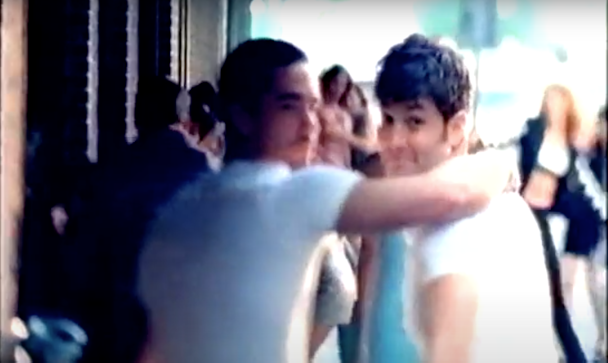Who are ‘ally brands’ really communicating to?
It is what brands do with their influence that makes a difference, not adding a rainbow logo to their social profiles for the 30 days of June. So writes Dentsu’s Lee Mabey as part of The Drum’s Marketing and the Marginalized Deep Dive.

Impulse’s ‘Chance Encounter’ was groundbreaking in 1998
It was on May 18 1998, as All Saints topped the chart with the double A-side Under the Bridge/Lady Marmalade and Arsenal celebrated completing the double, that the first TV ad portraying a gay couple aired in the UK.
Impulse’s ‘Chance Encounter’ was only screened after 11pm, so the chances of seeing it in a pre-YouTube world were remote, and by modern standards the spot is fairly innocuous. But I remember seeing it and being utterly mesmerized. 14-year-old me had seen the Tony and Simon kiss on EastEnders, but this was something else. The novelty of it was all rather exciting.
Progress to me would have been to then see gay life depicted in more ads. It seemed revolutionary at the time to consider a future where brands would feature a range of ethnic groups in TV spots, have trans spokespeople or people with disabilities in their marketing collateral. Fast forward to now and, regretfully, experiencing such things today can feel quite hollow.
Over 60% of consumers expect marketing to be inclusive, ergo marketers have reacted accordingly by upping diverse representation in brand communications. However, 63% of diverse groups do not feel represented in most advertising. It therefore begs the question – are marketers playing to an expectant public, or are they genuinely interested in engaging marginalized groups?
It saddens me when I speak with minority publishers who work on many briefs for Eid, Pride or Black History Month, only to be told the brand wants to work with a partner with ‘larger reach.’ Reach is the metric that kills inclusion. Our obsession with reach targets means we tend to forget the humans behind the numbers. It also means brands leave themselves open to accusations of virtue signaling. Working with both community-focused publishers and broadcast partners is therefore surely the best of both worlds. You can deliver your desired reach yet still demonstrate inclusion. And yet we seldom see this happen.
I wholeheartedly support brands depicting diverse communities. However, it must come from a position of understanding and trust. You cannot appear for one activation a year and never appear again. And yet many brands have failed to appreciate this simple truth. Many brands consider adding a rainbow logo to their social profiles for the 30 days of June as their demonstration of allyship. The truth is this token gesture does not make you an ally. It is what you do with your influence that makes a difference.
That’s why Co-op decided to drop the flag altogether, stating its support for queer employees and staff is year-round. This year’s Pride campaign ran on gay community radio station Gaydio. The retailer has a long track record of its support for LGBTQ+ rights, including being the only retailer to stand in parliament in support of equal marriage.
Authenticity is everything. Brands know audiences no longer accept inaction or misrepresentation. 64% of consumers choose or boycott brands based on the social or political issues they care about. While the socially-conscious consumer might appreciate a brand’s stance, it should always consider the lived experiences of the marginalized communities the brand purports to support.
Let’s recall the myriad brands and organizations voicing support for the Black Lives Matter movement last year. Like many of you, my timeline was flooded with black squares in solidarity against the injustices faced by Black people the world over. However, brands left themselves open to accusations of tokenism. For example, the model Munroe Bergdorf called out L’Oréal for its hypocrisy, having fired her two years prior for her comments around racial injustice and social disparity.
Compare this to the position of Lego. The toy company withdrew from sale in the US play sets featuring law enforcement officers and pledged $4m to organizations supporting Black children and educating all children about racial inequality – all during a time of heightened political discourse in the country. However, the firm has since faced accusations of rainbow-washing following the launch of its first Pride set, Everyone is Awesome, which was not supported by communications around its allyship for LGBTQ+ causes. It goes to show the challenges of balancing marketing toward the mass consumer and supporting inclusion.
If a brand wants to go beyond tokenism, its campaign should be a starting point – or an extension of its existing work in diverse communities. Brands that have done this well have a diverse group of marketers on their teams. They can serve to be the voice of the consumer and provide the lived experiences from those communities. Alignment with publishers operating within marginalized communities also offers alternative perspectives to what broadcaster publishers might bring when it comes to connecting with, rather than just reaching, a particular audience.
But most importantly, brands have a responsibility to accurately reflect the world. There is a 14-year-old out there who is feeling isolated, scared and unsure about their future. Marketers cannot imagine the power they have to help dispel those fears. Representation in ads means those people can be seen, feel validated and feel a sense of worth.
I should know. That 14-year-old was once me.
Lee Mabey is managing partner and DEI lead for media at Dentsu UK.
